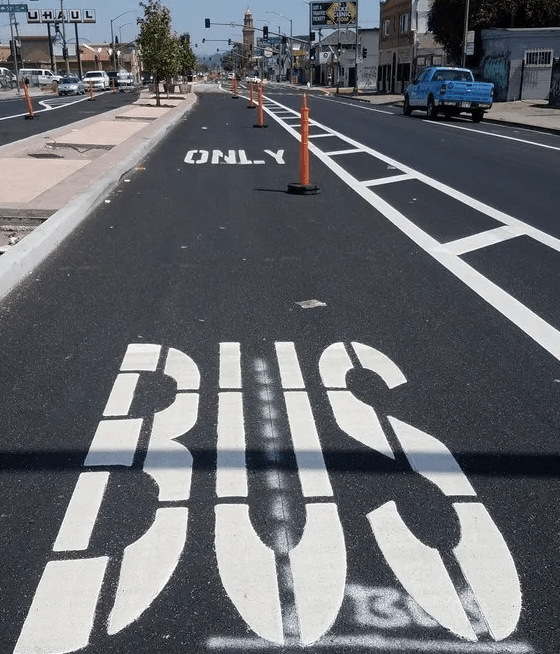AC Transit has issued a stern warning to motorists to stay out of the bus-only lanes on International Boulevard, as it enters the final phase of operator training for its Bus Rapid Transit (BRT) system from San Leandro to downtown Oakland. While this is certainly a good indication that the region's first, long-delayed BRT line is nearing completion, an opening date has still not been pegged.
"The pandemic has halted non-essential components of BRT," explained Robert Lyles, a spokesman for AC Transit. "Social distancing requirements have also slowed efforts of our construction crews."
"We have been conducting BRT operator training for several months," he added. "An unimpeded lane allows us to continue operator training."
But advocates, including those who first lobbied for the project, took the new warnings to motorists as a clear signal that the opening date is nigh:
14 years ago I was hired by @TransForm_Alert to help build community support for this project. There was no social media then. There was no other BRT like it to point to. It was all a dream, that is about to come true.... https://t.co/6EqirRuF31
— Joél T. Ramos (@Jo_elRamos) May 6, 2020
"We need more BRT in the Bay Area, and International Boulevard is an excellent corridor for it, as one of AC Transit's highest ridership corridors," wrote Ian Griffiths, co-founder and director of the advocacy group Seamless Bay Area, in an email to Streetsblog.
By the way, that's not a typo in the tweet from current SFMTA Local Government Affairs Manager Joél Ramos: he started lobbying professionally for BRT on International Boulevard some fourteen years ago.
As previously reported, between the environmental studies, the outreach, the engineering, and the construction, it’s taken since 1997 to get 7.6 miles of dedicated transit lane on International. “We’re at the very, very end” of the $240 million project, said AC Transit’s Robert del Rosario to a SPUR audience on bus transit in February. At the meeting, del Rosario said Oakland's BRT project would open in May. It was originally supposed to open in 2016, but that was pushed back first to 2017 and then 2019.
But one might think that before investing so much time and money on BRT, AC Transit and the powers-that-be would have prioritized integrating fares with the BART line that it parallels, so riders aren't double-dinged if they transfer. Physically, AC Transit's BRT system "has been designed to encourage transfers, but the fare structure discourages transfers," wrote Griffiths. "To optimize the efficiency of the system, people should be encouraged to take both BART and AC Transit in the most efficient combination possible to get to their destination."

There's no questioning that International BRT will be a immense improvement over current bus services. But as advocates from overseas have long suggested, important 'soft' transit improvements, such as simple, striped bus-only lanes, coordinated schedules and transfers, and integrated fares should come before the big projects get underway. And yet 23 years and a couple of hundred million dollars after this BRT project began, riders will still have to pay nearly the price of two full fares to transfer between it and BART.






